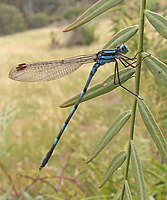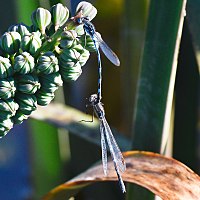Blue ringtail
| Blue ringtail | |
|---|---|

| |
| Male, Tasmania, Australia | |

| |
| Female, Tasmania, Australia | |
| Scientific classification | |
| Domain: | Eukaryota |
| Kingdom: | Animalia |
| Phylum: | Arthropoda |
| Class: | Insecta |
| Order: | Odonata |
| Suborder: | Zygoptera |
| Family: | Lestidae |
| Genus: | Austrolestes |
| Species: | A. annulosus
|
| Binomial name | |
| Austrolestes annulosus | |

| |
The blue ringtail (Austrolestes annulosus) is an Australian damselfly.[1] It is found on most of the continent.
Taxonomy[edit]
The blue ringtail was first described by Edmond de Sélys Longchamps in 1862.[3]
Description[edit]
The abdomen is 3 cm long.[4] It can easily be confused with Coenagrion lyelli or Caliagrion billinghursti, but can be differentiated through dorsal patterns. They are a thin, medium-sized damselfly with varying coloration, which depends on maturity and temperature. However most are a striking blue with minimal black markings. Females are slightly more robust than males, and have a black and white/pale blue coloration.
Distribution and habitat[edit]
It is widely distributed in most of Australia, except for the northern and north-eastern parts.[3] It is active through September to April in still water bodies such as riverine pools, lakes and ponds, including temporary pools.
Gallery[edit]
-
Male
-
Mating pair
-
Female wings
-
Male wings
References[edit]
- ^ a b Dow, R.A. (2017). "Austrolestes annulosus". IUCN Red List of Threatened Species. 2017: e.T87534133A87539919. doi:10.2305/IUCN.UK.2017-1.RLTS.T87534133A87539919.en. Retrieved 20 November 2021.
- ^ Selys-Longchamps, E. (1862). "Synopsis des Agrionines, seconde légion: Lestes". Bulletin de la Classe des Science, Académie Royale de Belgique. 2 (in French). 13: 288–338 [332].
- ^ a b "Species Austrolestes annulosus (Selys, 1862)". Department of the Environment, Water, Heritage and the Arts. October 9, 2008. Archived from the original on April 2, 2011. Retrieved 2009-09-18.
- ^ Daley, Elizabeth; Daley, Anthony (2007). Wings: an introduction to Tasmania's winged insects. Riffles Pty. Ltd. p. 7. ISBN 978-0-9804006-2-5.
 Media related to Austrolestes annulosus at Wikimedia Commons
Media related to Austrolestes annulosus at Wikimedia Commons





